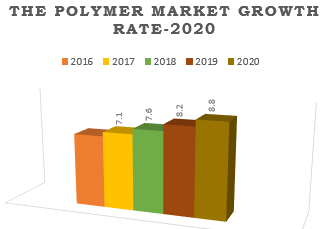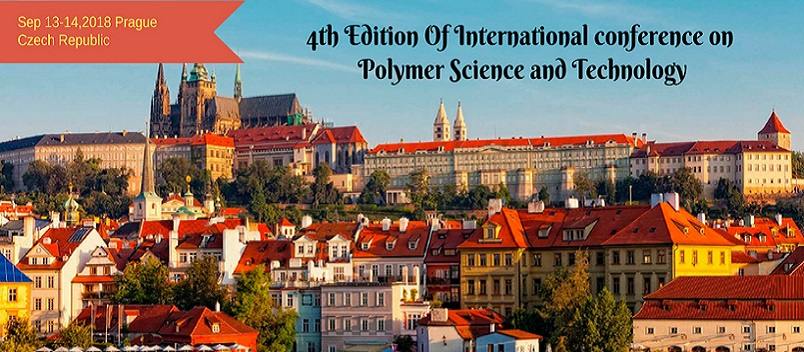Theme: Delve into the Recent Findings and Advents in the Field of Polymer Science
Euro Polymer Science 2018
Thank you everyone for making the conference a Grand Sucess
Conference series cordially invites participants from all over the world to attend 4th Edition of international conference on polymer science and technology .mainly focused on theme:“Delve into the Recent Findings and Advents in the Field of Polymer Science” Explore the latest advances in Polymer science and Technology happening in USA, Europe, Asia, Japan and Czech Republic at Conference on Polymer Science and Technology held during September 13-14, 2018 Prague, Czech Republic
On behalf of the Organizing and Program Committee we take great pleasure ,to Bring together pioneers world-class professors, researchers, scientists and students across the world to share and exchange their experiences in each and every allied concepts of polymer science .from research areas of Polymer Science, Chemistry , Nanotechnology and Physics to share their recent innovations and applications in several fields and indulge in collaborative discussions and technical sessions at the event. The Conference will also have a space for institutions and/or companies to present their amenities, products, innovations and research results.
Euro polymer science 2018, is great fortuity to share and interchange theoretical knowledge and technical in polymer science . There will be many seminars, workshops and technical sessions that are going to take place which will grab the attention of the professionals to attend the conference. And we assure you that, Polymer Science 2018 will be the ideal place to meet the Conspicuous Researchers of Polymer Science and Prague Czech republic is the populous tourist place where you can give your family a perfect tourism experience.
Track 1: Polymer Industry Market :
Polymer ultimatum in Europe The European polymer market has long been recognized amongst the world leaders. It is currently facing apparently constraining maturity in the West and the question is now, of how to add value throughout the supply chain. Central Europe is seeing increasing investment in industrialized and plastic processing, with many countries profiting from free access to the single market coupled with a low production costs. Russia and the former Soviet Union Republics still have masses of unfulfilled potential, deteriorated by poor republics relations and economics. The smaller states in the region are experiencing a quick expansion of technological capability which offers great opportunities, however at the same time, threatens long established markets in the west. The European market is huge and diverse and despite increasing globalization, opportunities are present in today’s climate. Without high quality data it is difficult to plan future investments and marketing strategies. AMI’s latest report provides detailed statistical analysis of where growth opportunities lie and the nature of the industry. This report will assist any company wishing to better understand the European plastics industry
AMI's 2015 European Plastics Industry Report, European polymer markets are forecast to grow by 1.3% this year, building on a recovery of less than 1% for 2014. However, even this modest gain is under risk from the region's tight supply for many materials and rapidly rising prices.As a result the European plastics industry in 2015 finds itself in another period of upheaval and change as it looks to pull out of the stagnation caused first by the Great Recession in 2008-2009 and then by the Eurozone crisis 2012-2013. In the two years since AMI published its last review, in 2013, demand has barely shifted from just over 36 million tones and the volume of polymers consumed in 2014 was still some 10% below that used in 2007 before the Great Recession hit.
Related Societies:- Portuguese Chemical Society, Chemical Industries Association, Swedish Chemical Society, Australian-European Polymer Symposium , Chromatographic Society of India, European Polymer Federation Congress, Czech Chemical Society, Hungarian Society for Separation Science, Federation of Asian Chemical Societies, Polymer Society of Korea , Royal Netherlands Chemical Society (KNCV).
Track 2: Polymer Science and Technology
Polymers offer extent opportunities towards newer applications in industrial science important areas. There is a great prerequisite, to have an intrinsic approach towards this compatible relationship of polymers and their performance. Before go in to brief description of polymer we now look in to outlook of the polymer science. Polymer has been with us from the beginning of time they form the very basic building blocks of life. Starting from animals, plants and human beings all classes of living organisms are composed of polymers .the term polymer is derived from Greek its nothing but ‘many parts’. Polymer is long chain molecule made up of small particles called monomers. It is also called as macromolecule polymer is a raw material which we used to call as plastic. Which is true man-made materials.as we shall see in subsequent discussions the use of polymeric materials has permeated every facet of our lives.it is hard to imagine today’s world with all its luxury and comfort without man-made polymeric industries
Related Societies:- Portuguese Chemical Society, Chemical Industries Association, Swedish Chemical Society, Australian-European Polymer Symposium , Chromatographic Society of India, European Polymer Federation Congress, Czech Chemical Society, Hungarian Society for Separation Science, Federation of Asian Chemical Societies, Polymer Society of Korea , Royal Netherlands Chemical Society (KNCV).
Track 3: Polymer Chemistry
Polymer chemistry is a chemistry branch which deals with structures and their properties.it is also known as macromolecular chemistry. Processing of macromolecule is called as polymer . Polymer chemistry also deals with problems related to Medicine, Biology, Biochemistry and Material Science; however, Polymer Chemists focus on synthetic organic polymers due to their commercial importance. It is all about analysing how the monomers merge to generate useful substances with the desired features by manipulating their molecular structure, the composition, and applying chemical and processing techniques that can impact the properties of the final product.
Related Societies:- Portuguese Chemical Society, Chemical Industries Association, Swedish Chemical Society, Australian-European Polymer Symposium , Chromatographic Society of India, European Polymer Federation Congress, Czech Chemical Society, Hungarian Society for Separation Science, Federation of Asian Chemical Societies, Polymer Society of Korea , Royal Netherlands Chemical Society (KNCV).
Track 4: Polymer Physics
Polymer physics is a interdisciplinary of physics which deals with polymers, their fluctuations, mechanical properties, polymer structures and also with the kinetics.it includes theory and experimental behavior of polymeric solution The analytical approach for polymer physics is based on an similarity between a polymer and either a Brownian motion, or other type of a random walk, the self-avoiding walk. The simplest desirable polymer model is presented by the ideal chain, corresponding to a simple random walk. These fact-finding methods also helped the mathematical modeling of polymers and even for a better understanding of the properties of polymers.
Related Societies:- Portuguese Chemical Society, Chemical Industries Association, Swedish Chemical Society, Australian-European Polymer Symposium , Chromatographic Society of India, European Polymer Federation Congress, Czech Chemical Society, Hungarian Society for Separation Science, Federation of Asian Chemical Societies, Polymer Society of Korea , Royal Netherlands Chemical Society (KNCV).
Track 5: Biopolymers
“Polymeric biomolecules” or the Biopolymers are polymers fabricated by living organisms. Polynucleotides, Nucleotides and Polypeptides are the three main classes of polymers those are called long polymers.it also have short polymer of amino acids and polysaccharides which are frequentlylinear bonded polymeric carbohydrate structure for example examples: rubber, suberin, melanin and lignin.
Structure of the biopolymer has a well- defined. The difference between biopolymer and synthetic polymer can be found in their structure .compare to biopolymer synthetic polymer has much simplest structure. This fact shows to a molecular mass distribution that is missing in biopolymers. All biopolymers are alike That they all contain the similar sequences and numbers of monomers and thus all have the same mass.
Related Societies:- Portuguese Chemical Society, Chemical Industries Association, Swedish Chemical Society, Australian-European Polymer Symposium , Chromatographic Society of India, European Polymer Federation Congress, Czech Chemical Society, Hungarian Society for Separation Science, Federation of Asian Chemical Societies, Polymer Society of Korea , Royal Netherlands Chemical Society (KNCV).
Track 6: Polymer Rheology:
The study of flow of matter is known as Rheology basically in a liquid state, but also responds for "soft solids" or solids like plastic flow rather than deforming elastically in response to applied force. It is a department of physics which deals with the deformation and flow of materials, both solids and liquids. Rheology generally accounts for the behavior of non-Newtonian fluids, by distinguish the minimum number of functions that are needed to relate stresses with rate of change of strain or strain rates. Rheometry is experimental characterization of a material's rheological behavior .In execution, rheology is principally concerned with prolong continuum mechanics to characterize flow of materials, that indicates a combination of elastic, viscous and plastic behavior by properly combining elasticity and (Newtonian) fluid mechanics. Rheology has many application in polymer science and engineering, pharmaceutics, biology and physiology.
Related Societies:- Portuguese Chemical Society, Chemical Industries Association, Swedish Chemical Society, Australian-European Polymer Symposium , Chromatographic Society of India, European Polymer Federation Congress, Czech Chemical Society, Hungarian Society for Separation Science, Federation of Asian Chemical Societies, Polymer Society of Korea , Royal Netherlands Chemical Society (KNCV).
Track 7: Nanomaterial and Nanotechnology:
In nanomaterial and nanotechnology the term ‘Nano’ is derived from the Greek ‘Nanos ‘which is known as extremely small particle. Basically nanomaterial is material with dimensions on the nano-scale.structure at Nano-scale has unique optical, electronic, or mechanical properties. Actually nanomaterial’s cover huge areas of materials of materials, many of which we would not normally consider to be particularly revolutionary. Because nature is full of nanomaterial’s and Nano-structure. Nanotechnology is the engineering of operative systems at the molecular scale. This covers both present work and concepts that are more advanced. In this real world today the nanotechnology has ability to bulid products using techniques and equipments to produce completly high performance products. The idea that seeded nanotechnology were first discussed in 1959 by renowned physicist Richard Feynman in his talk There's Plenty of Room at the Bottom in which it explained about the possibility of synthesis via direct manipulation of atoms
Related Societies:- Portuguese Chemical Society, Chemical Industries Association, Swedish Chemical Society, Australian-European Polymer Symposium , Chromatographic Society of India, European Polymer Federation Congress, Czech Chemical Society, Hungarian Society for Separation Science, Federation of Asian Chemical Societies, Polymer Society of Korea , Royal Netherlands Chemical Society (KNCV).
Track 8: Polymer Engineering
Polymer Engineering is a sub discipline of the polymer science basically it focusing on the development of new product .Its also covers details of the polymerization structure petrochemical industry and characterization of polymers, properties of polymers, compounding and processing of polymers and description of major polymers, structure property relations and applications. Polymer engineers use the theory of thermodynamics, plant design, process design, and transport phenomena to develop new products. Polymer engineers can oversee the production process of plastics and other polymers as well.
Related Societies:- Portuguese Chemical Society, Chemical Industries Association, Swedish Chemical Society, Australian-European Polymer Symposium , Chromatographic Society of India, European Polymer Federation Congress, Czech Chemical Society, Hungarian Society for Separation Science, Federation of Asian Chemical Societies, Polymer Society of Korea , Royal Netherlands Chemical Society (KNCV).
Track 9: Ceramic and Composite Materials:
Ceramics and composite materials are the sub discipline of material science.it contains compounds which includes ionic and covalent bonds to form a material with high modulus and hardness, high thermal expansion, high melting point and corrosion resistance. Because these materials may be breakable, toughness fracture is also an important mechanical property. Composites are made up of two or more materials with different mechanical properties that produce a desired set of properties when combined. Advanced ceramic and composite materials are applied to many,automotive industries, renewable or alternative energy,electronics, healthcare, and aerospace. By using scanning electron microscopy(SEM) microstructure of ceramic material is characterized.
Related Societies:- Portuguese Chemical Society, Chemical Industries Association, Swedish Chemical Society, Australian-European Polymer Symposium , Chromatographic Society of India, European Polymer Federation Congress, Czech Chemical Society, Hungarian Society for Separation Science, Federation of Asian Chemical Societies, Polymer Society of Korea , Royal Netherlands Chemical Society (KNCV).
Track 10: Radiation-Related Polymer:
Polymer Materials Radiation Processing and its Industrial Applications systematically explains the materialistic viable ways to process and shows how radiation-process used polymeric materials in industrial products. Either by conventional chemical means or by exposure to ionization radiation from ether radioactive sources or highly accelerated electrons the modifications in polymeric structure of plastic material are made. Increased utilization of electron beams for reconstruction and magnification of polymer materials has been in particular witnessed over the past 40 years. The electrical properties of polymers present almost limitless scope for industrial research and development. Applications of organic electronic devices are in displays, photovoltaic, sensors, logic, lighting and radio-frequency identification tags. By 2018 Their market is predicted to be more than $44 billion globally .
Related Societies:- Portuguese Chemical Society, Chemical Industries Association, Swedish Chemical Society, Australian-European Polymer Symposium , Chromatographic Society of India, European Polymer Federation Congress, Czech Chemical Society, Hungarian Society for Separation Science, Federation of Asian Chemical Societies, Polymer Society of Korea , Royal Netherlands Chemical Society (KNCV).
Track 11: Applications of Polymer Science:
In todays world people can’t survive without the applications of polymer they play a vital role in our day to day life .Polymers are a highly distinct class of materials which are available in all fields of technology from avionics through drug delivery system, bio-sensor devices, Holography, 3D printing, tissue engineering, cosmetics etc. and the usage and improvement of these depends on polymer applications .due to their below average cost and ease to manufacture the application of polymeric materials and their composites are increased .This in turn fuels further development in research.which include of bio plastics substances for medical, dental and pharmaceutical use have hovered on the front lines for years.gelatin based capsules which are naturally dissolve in digestive tract are made up of animal or vegetable matter, which do not require manual removal after healing, are regularly used to suture wounds and surgical incisions.
Related Societies:- Portuguese Chemical Society, Chemical Industries Association, Swedish Chemical Society, Australian-European Polymer Symposium , Chromatographic Society of India, European Polymer Federation Congress, Czech Chemical Society, Hungarian Society for Separation Science, Federation of Asian Chemical Societies, Polymer Society of Korea , Royal Netherlands Chemical Society (KNCV).
Track 12: Recent Innovation’s in Polymer Science and Technologies:
Polymers are the one of the modern man-made substance that can be used as matrix for fabrication of composites and Nano composites they can integrate a wide range of products like carbon ,ceramic and metals in the form of fibers which improves physical and chemical properties of the polymer. Coming from medical to electrical the polymers are created so many research and developments.
Related Societies:- Portuguese Chemical Society, Chemical Industries Association, Swedish Chemical Society, Australian-European Polymer Symposium , Chromatographic Society of India, European Polymer Federation Congress, Czech Chemical Society, Hungarian Society for Separation Science, Federation of Asian Chemical Societies, Polymer Society of Korea , Royal Netherlands Chemical Society (KNCV).
Track 13: Polymers and the Environment
Today The conventional polymer materials are available , exclusively the plastics, which is the result for decades of evolution. utilization of raw materials and energy, as well as of waste release the production is extremely efficient .These products show an excellent property like to water and high mechanical strength to microorganisms, it is low-cost due to manufacturing scale ,low density especially for transporting goods and process optimization. However, some of their most useful features, the chemical, physical and biological inertness, and durability resulted in their accumulation in the environment if not recycled. Unfortunately, the build-up of plastics, along with other materials, is becoming a serious worry for all countries in the world. These materials occupy significant volume in landfills and dumps today. Recently, the presences of huge amounts of plastic waste items are dumped into the oceans has been observed, from different sources like streets, going through the drains with the rain, and then going into the rivers and lakes, and then to the oceans. Those materials are harmful for living organism and it can affect the ecosystem too. So, these wastes should be recycled or managed under systematic method. As it leads , there is a very strong and irreversible movement, in all countries of the world, to use materials that do not harm the planet, that is, low environmental impact materials.
Related Societies:- Portuguese Chemical Society, Chemical Industries Association, Swedish Chemical Society, Australian-European Polymer Symposium , Chromatographic Society of India, European Polymer Federation Congress, Czech Chemical Society, Hungarian Society for Separation Science, Federation of Asian Chemical Societies, Polymer Society of Korea , Royal Netherlands Chemical Society (KNCV).
Track 14: Polymer Science – The Next Generation
The leading anxieties for humans in the future will be energy resources, food, health, mobility & infrastructure and communication. in the upcoming decades the notable challenges will be the population that is increasing gradually, the concentration of people in expansive urban centers, globalization and the expected change of climate. undoubtedly that polymers will play a key role in finding successful ways in handling these challenges. Polymers will be the material of the new millennium and the production of polymeric parts i.e. sustainable, green,, energy-efficient, high low-priced ,quality , etc. will assure the availability of the finest solutions round the globe.since a lomg time Synthetic polymers have played a relatively important role in current medicinal practice. Successfully using synthetic polymer many devices in medicine and even some artificial organs are made and smart polymers for microfluidics and Self-healing and reprocessable. In various industrial applications polymer systems have been employed. to preserve energy and improve renewable energy technologies polymer science can be applied..
Related conferences:
10th International Conference on Chemistry Education, June 21-22, 2018 Oslo, Norway; 4th International Conference on Polymer Chemistry, June 27-28,2018 Stockholm, Sweden; 9th Global Chemistry Congress, July 23-24, 2018, Lisbon, Portugal; 9th World Congress on Green Chemistry and Technology, September 17-19,2018, Amsterdam, Netherlands; 5th World Congress on Chemical Engineering and Catalysis, August 28-30, 2018, Paris, France;10th International Conference on Separation Techniques, October 22-24,2018,Budapest,Hungary; 6th European Biopharma Congress September 18-19, 2018, Amsterdam, Netherlands; 8th World Congress on Spectroscopy and Analytical Techniques August 15-17, 2018, Stockholm, Sweden.
Related Societies:- Portuguese Chemical Society, Chemical Industries Association, Swedish Chemical Society, Australian-European Polymer Symposium , Chromatographic Society of India, European Polymer Federation Congress, Czech Chemical Society, Hungarian Society for Separation Science, Federation of Asian Chemical Societies, Polymer Society of Korea , Royal Netherlands Chemical Society (KNCV).
Summary:
Polymer science is advancing every day The utilization and handling of polymer has been one of the primary main thrusts of improvement and success since the beginning of progress.The being linear molecular weights of hundreds with large molecules , thousands, and even millions is today a recognized fact. For today billions of dollars of technology and an army of, scientists engineers, technicians, and (more than 60,000 in the United States alone) work with materials which often share only the common title, polymer. These workers and their predecessors have produced numerous variations of polymers, each with assets designed to satisfy certain benchmark. Research in the field of polymer research is so active that more than 60,000 . This description covers both normal, conventional polymer and manufactured, composed polymer.
Important and scope:
Polymer science field of material has helped in advancement in various fields of science and technology. the polymer industry has rapidly developed and is larger than the copper, steel, aluminum and some other industries combined. Both natural and synthetic polymers are remarkably involved in comfort and facilitation of human life and are responsible for life itself, for medication, nutrition, communication, transportation, irrigation, container, clothing, recording history, buildings, highways, etc. In fact, it is challenging to imagine human society without synthetic and natural polymers. In our ever-increasing technological world, science plays a crucial role in providing solutions to critical problems of air, clean, and abundant water, food, energy, and health. The awareness of polymers and related texts provide both the statistics and insights of their better understanding in our life.
Why Prague:
Prague is the capital city of Czech Republic the heart of Europe, it is situated in the middle of the Europe with temperate climate, with warm summers and chilly winters .Prague is the most beautiful city in the Europe, it is the14th largest city in the European union Also, it is home to about 2 million people and it has wide range of universities including the oldest Charles University in Prague in Central Europe. Prague is the fifth most visited European city after Paris, London, Istanbul and Rome. Prague's low cost of living makes it a popular destination for expats relocating to Europe. Prague owns many popular historical sites and more than ten major museums, along with numerous theatres, galleries, cinemas. In 2016 in the trip advisor world list of best destination Prague is ranked sixth place and the city receives more than 6.4 million international visitors annually, as of 2014. The most attractive places in Prague are Charles Bridge, Tyn Church, Wenceslas Square, Prague Castle and many more….
Why to attend:
Euro polymer science-2018 which is going to be the leading conference devoted to polymer science provides a foremost technical forum for sharing and learning about the current research and advancements, along with conversing new applications and technologies. From all over the world there will be presentations on main topics by professional and leading working groups and panels.
The main objective of the conference is to focused on finding out about Polymer science and Technology, this is the best chance to meet many great professionals, scientists from throughout the World. It Conduct shows, debates poster presentations spreads the data and acknowledgment at this occasion .Broadly acclaimed speakers, the latest methods, strategies, and the up to date services in Polymer science and technology are signs of this conference.
Traget Attendees:
- Eminent Scientists of Polymer Science & Engineering
- Polymer Professors
- Research fellows
- Students
- Directors of Polymer companies
- Chemical Engineers
- Polymer Associations
Glance on market report:
The polymer industries recreated the world which we are living today.in various categories coming from day to day commodities or technology. Polymers, resins, coatings, films and composites are major areas of the plastics market covered. From key market drivers we can forecast and trends the future of the plastic industry . In-depth company profiles and patent analysis will help understand the emerging technologies and applications by key market players and stakeholders
The global polymer market (2016–2021) is estimated to reach USD 171.96 Billion by 2021 at a CAGR of 8.5%. The report covers the polymer foam market by resin type, such as polyurethane (PU), polystyrene (PS), polyvinyl chloride (PVC), phenolic, polyolefin, melamine and others; by application, such as packaging, building & construction, and others; and by region, namely, North America, Europe, Asia-Pacific. Base year considered for the study is 2015, while the forecast period is between 2016 and 2021. The rise in demand for polymer foams in applications, such as automotive, building & construction, and packaging facilitates the growth of the market. The European polymer industries makes the most significant contribution to the welfare in Europe by enabling innovation, creating quality of life to citizens and facilitating resource efficiency and climate protection. Almost more than 1.5 million people are working in 60,000 companies (mainly small and medium sized companies in the converting sector) to create a turnover above 340 bn EUR per year. The plastics industry includes polymer producers - represented by Plastics Europe, converters - represented by EuPC and machine manufacturers - represented by EUROMAP.
About 1.1 million tonnes primary plastics were produced in Austria in 2010, and with additional trade of polymers and semi-finished and final products, 1.3 million tonnes plastic products are used for Austrian consumption. This consumption is distributed over ten consumption sectors, of which packaging (24%), non-plastic products (20%), building and construction (18%), and others (13%) are the most important ones. After the use phase, around 53% of the waste material is incinerated with energy recovery, one third of the plastics waste flow is recycled mechanically, and roughly 11% is used for feedstock recycling. Only minor fractions of the waste flow are landfilled or reused. These results highlight the most relevant streams, which can help to focus time and resources on the main processes or sectors, especially for waste management, to guide the current and future waste flows to the most ecologically and economically optimal treatment
Global level applications of Polymers in Various Industries:

Estimated Global Polymer Market Growth Rate by 2020:
The Global High Performance Polymers Market is poised to grow at a CAGR of around 6.5% in the next 3 years to reach approximately $8.8 billion by 2020. The study focuses on market trends, leading players, supply chain trends, technological innovations, key developments, and future strategies. The report provides comprehensive market analysis across four major geographies such as North America, Europe, Asia Pacific and Other parts of the world

Thanks for attending Polymer Science 2017!!
Another Polymer Science and Engineering has been successfully completed - The 3rd edition – and we must Thank the attendees, DoubleTree by Hilton Hotel & Conference Centre Staff, and the Organizing Committee, Ad-Sponsors & Media partners and everyone else that helped to make this 3rd International Conference on Polymer Science and Engineering with the theme: Journey from innovations to applications of new generation technologies a successful conference.
To Attendees,
We hope that you obtained the kind of advance technical information in the arena of Material Science and Engineering that you were seeking, and that your role in the field has been enhanced via your participation. We hope that you were able to take part in all the sessions and take advantage of the tremendous advancements in Polymer Science and Engineering that scientists are working with.
If you have any feedback for us for future consideration or enhancements of this Conference, please provide your feedback to Conference Manager.
Gloria Anderson at polymerscience@materialsconferences.org
The meeting covered various sessions, in which the discussions included the scientific tracks:
Polymer Science – The Next Generation
Polymers and the Future of Industries
Polymer Nanotechnology
Polymer Chemistry
Composite Polymeric Materials
Polymer Physics
Applications of Polymers
Advanced Polymer Structures
Role of Polymers in biology and biological systems
Polymer Material Science and Engineering
The Keynote presentations were given by:
Mosongo Moukwa | PolyOne Designed Structures and Solutions LLC | USA
René Hensel | INM – Leibniz Institute for New Materials | Germany
Dukjoon Kim | Sungkyunkwan University Suwon | Korea
Ana Barros-Timmons| University of Aveiro | Portugal
Richard J. Spontak| North Carolina State University | USA
Nekane Guarrotxena | Spanish National Research Council (CSIC) | Spain
Bookmark your dates: We hope to see you at Euro Polymer Science 2018, Prague Czech republic September 13-14, 2018
Organizing Committee
Polymer Science 2017
Conference Highlights
- Polymer Science and Technology
- Polymer chemistry
- Polymer Physics
- Biopolymers
- Polymer Rheology
- Nanomaterials and Nanotechnology
- Polymer Engineering
- Ceramics and Composite Materials
- Radiation-Related Polymer
- Applications of Polymer Science
- Recent inovations in Polymer Science and Technologies
- Polymers and the Environment
- Polymer Science – The Next Generation
- Polymer Industry Market
To share your views and research, please click here to register for the Conference.
To Collaborate Scientific Professionals around the World
| Conference Date | September 13- 14, 2018 | ||
| Sponsors & Exhibitors |
|
||
| Speaker Opportunity Closed | Day 1 | Day 2 | |
| Poster Opportunity Closed | Click Here to View | ||
Useful Links
Special Issues
All accepted abstracts will be published in respective Our International Journals.
- Journal of Polymer Science & Applications
- Journal of Research & Reviews in Polymer
- Journal of polymer science
Abstracts will be provided with Digital Object Identifier by















